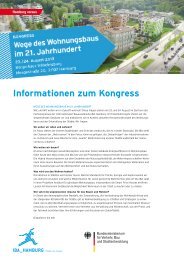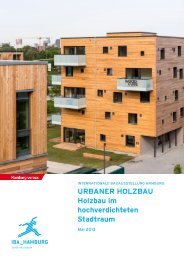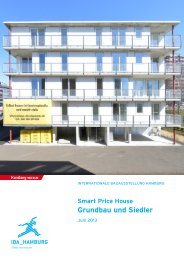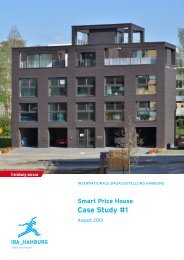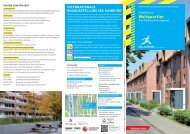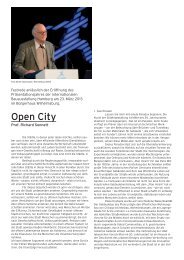Hafen-Logistik-Stadt - IBA Hamburg
Hafen-Logistik-Stadt - IBA Hamburg
Hafen-Logistik-Stadt - IBA Hamburg
Sie wollen auch ein ePaper? Erhöhen Sie die Reichweite Ihrer Titel.
YUMPU macht aus Druck-PDFs automatisch weboptimierte ePaper, die Google liebt.
<strong>IBA</strong>-LABOR 1 HAFENVERKEHR HAFEN - LOGISTIK UND STADTENTwIcKLUNG<br />
- STADT<br />
During the 1970s and 1980s, many North Ameri-<br />
can and European port-cities reported that de-<br />
caying piers and expanding inter-city blight were<br />
associated with social pathologies and were the<br />
subject of much concern among urban residents<br />
and local, regional and national governments.<br />
In 1979, for example, a group of planners, politicians<br />
and scholars met in Cambridge, Massachusetts<br />
under the auspices of the U.S. National<br />
Academy of Sciences and its Urban Waterfront<br />
Group to consider problems and opportunities<br />
associated with changing port city relations and<br />
their urban waterfronts. The cases presented<br />
and the follow-up discussions at the conference<br />
focused on many North American cities that were<br />
suffering from the consequences of closed-down<br />
or relocated waterfront related industry and shipping<br />
facilities.<br />
A few years later in 1987, the Department of Geography,<br />
University of Southampton, U.K. hosted<br />
a major academic conference on global dimensions<br />
of waterfront developments. This first academic<br />
conference to examine global dimensions<br />
of port-city relations focused on a growing obsolescence<br />
of once vibrant waterfronts as economic<br />
restructuring, new shipping technologies, and<br />
the closing down and moving out of industrial<br />
establishments took hold. Brian Hoyle presented<br />
his model of port-city relations during the 20th century that provided a context for understanding<br />
patterns of urbanization, such as industrialization,<br />
de-industrialization and re-development.<br />
He identified five successive stages of waterfront<br />
development: the primitive cityport, the expanding<br />
city port, industrial cityport, retreat from the<br />
waterfront, and redevelopment. According to his<br />
model, changes in patterns of economic activities<br />
and new technological developments were the<br />
primary forces that gave rise to new spatial and<br />
functional relations between the port and its city.<br />
In the two decades since the Southampton<br />
conference, change on urban waterfronts has<br />
proliferated. There have been major development<br />
projects from Oslo to Hong Kong, from Dubai to<br />
<strong>Hamburg</strong>, from Rio de Janeiro to Vancouver, and<br />
from Shanghai to Glasgow. Not only has a spatial<br />
expansion and integration of the global economy<br />
been fundamental to these projects, but new<br />
technological developments in the form of larger<br />
ships, more accurate navigation and communication<br />
systems, as well as further refinement of<br />
inter-modal systems have also played an important<br />
role in advancing shipping operations.<br />
Central to the most recent phase of redevelopment<br />
is an over-arching concern with globalization.<br />
I contend that to understand transformations<br />
taking place in globalized urban areas,<br />
waterfronts must be considered not merely as<br />
physical spaces where land and water meet.<br />
Rather they must be regarded as spaces of relations<br />
where many economic, political and environmental<br />
influences come together in a web of<br />
intense flows and linkages. Making sense of the<br />
physical reality of waterfront change requires<br />
consideration of non-territorially based relationships.<br />
Waterfront change is linked not only to<br />
plans formulated by partnerships of development<br />
corporations, local-state agencies and special<br />
purpose bodies, but it is also connected to myriad<br />
regulatory, economic, political and environmental<br />
systems that have little regard for administrative<br />
boundaries.<br />
Consequently, waterfronts matter because they<br />
are so intimately involved with the multi-layered<br />
dynamics of urban change. I do not mean to<br />
essentialize urban waterfronts as places where<br />
“everything” occurs. Focusing on a microcosm<br />
can cause problems in terms of research and<br />
analysis, and I wish to avoid an understanding of<br />
urban waterfronts as static or essential spaces.<br />
Urban waterfronts are not objects of study where<br />
attention is focused solely on what occurs within<br />
the terrain of the waterfront area. Rather, they<br />
are inextricably connected with decisions and<br />
phenomena that occur at varied scales.<br />
An emphasis on the relational and fluid connections<br />
between and within scales of analysis<br />
provides a more rigorous method by which to<br />
analyze the reproduction of spatial areas. Urban<br />
1



